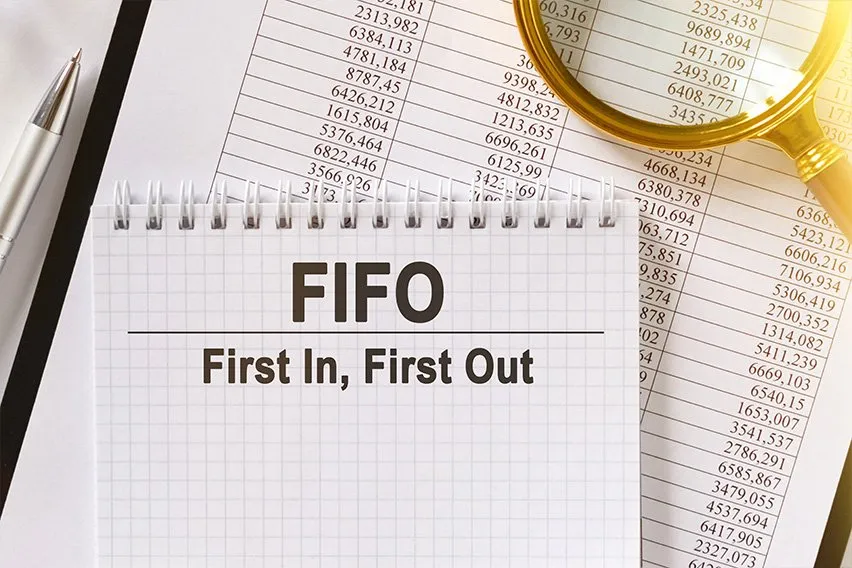What Is FIFO Method: Definition and Guide

FIFO, or First In, First Out, is a method of inventory valuation that businesses use to calculate the cost of goods sold. It assumes that a business always sells its oldest products first.
FIFO is straightforward and intuitive, making it popular as an accounting method and useful for investors and business owners trying to assess a company’s profits. It’s also an accurate system for ensuring that inventory value reflects the market value of products.
We’ll explore how the FIFO method works, as well as the advantages and disadvantages of using FIFO calculations for accounting. We’ll also compare the FIFO and LIFO methods to help you choose the right fit for your small business.
Key Takeaways
- FIFO, or First In, First Out, is a common method of business inventory valuation.
- FIFO assumes that a company sells its oldest products first.
- Advantages of FIFO include cost accuracy, simplicity, and regulatory compliance.
- An alternative method to FIFO is LIFO, or Last In, First Out.
- FIFO typically results in higher net profits being recorded on the balance sheet.
Table of Contents
- What Is FIFO?
- How FIFO Method Works
- FIFO Example
- Advantages of FIFO
- Disadvantages of FIFO
- FIFO vs. LIFO
- Best Practices for FIFO
- Conclusion
- Frequently Asked Questions

What Is FIFO?
FIFO is an inventory valuation method that stands for First In, First Out, where goods acquired or produced first are assumed to be sold first. This means that when a business calculates its cost of goods sold for a given period, it uses the costs from the oldest inventory assets.
In some cases, a business may not actually sell or dispose of its oldest goods first. However, FIFO assumes that it does so for the sake of accounting. A company should generally be able to justify why it selects a certain used inventory method—even if it’s not completely strict about selling all the oldest goods first, companies that use FIFO generally follow that procedure.
How FIFO Method Works
When a business manufactures a product, it incurs a cost of goods sold, which refers to the costs associated with producing that product. The business recognizes these costs as an expense and must record them in its accounts.
As the price of labor and raw materials changes, the production costs for a product can fluctuate. That’s why it’s important to have an inventory valuation method that accounts for when a product was produced and sold. FIFO accounts for this by assuming that the products produced first are the first to be sold or disposed of.
To calculate the value of inventory using the FIFO method, calculate the price a business paid for the oldest inventory batch and multiply it by the volume of inventory sold for a given period.
For example, a company purchases 100 items at $15 each and later purchases 100 items at $20 each. It sells 75 items. FIFO assumes that those 75 items sold cost the company $15, so the cost of goods sold for that period would be $1,125.
Learn more about how to calculate FIFO.
FIFO Example
Sal’s Sunglasses is a sunglass retailer preparing to calculate the cost of goods sold for the previous year. Sal will use the FIFO method.
Here is what his inventory costs are:
| Month | Amount | Price Paid |
| September | 200 sunglasses | $200.00 per |
| October | 275 sunglasses | $210.00 per |
| November | 300 sunglasses | $225.00 per |
| December | 500 sunglasses | $275.00 per |
Sal sold 600 sunglasses during this time, out of his stock of 1275.
Going by the FIFO method, Sal needs to go by the older costs (of acquiring his inventory) first.
Sal’s COGS calculation is as follows:
200 x $200.00 = $40,000.
275 x $210.00 = $57,750.
125 x $225.00 = $28,125.
COGS Total: $125,875.
Sal’s total cost of goods sold is $125,875.
The remaining unsold 675 sunglasses will be accounted for in “inventory”.
Sal can use the cost of goods sold to help determine his profit.
Advantages of FIFO
There are several advantages to using the FIFO method for inventory valuation:
Simple and Intuitive
FIFO is a straightforward valuation method that’s easy for businesses and investors to understand. It’s also highly intuitive—companies generally want to move old inventory first, so FIFO ensures that inventory valuation reflects the real flow of inventory.
Regulation Compliance
Using the FIFO method makes it more difficult to manipulate financial statements, which is why it’s required under the International Financial Reporting Standards. Depending upon your jurisdiction, your business may be required to use FIFO for inventory valuation.
Cost Accuracy
FIFO is also the most accurate method for reflecting the actual flow of inventory for most businesses. In normal economic circumstances, inflation means that the cost of goods sold rises over time. Since FIFO records the oldest production costs on goods sold first, it doesn’t reflect the current economic situation, but it avoids large fluctuations in income statements compared to LIFO.
Disadvantages of FIFO
There is also a disadvantage to calculating inventory value using FIFO:
May Not Reflect Inventory Flow
In some cases, a business may use FIFO to value its inventory but may not actually move old products first. If these products are perishable, become irrelevant, or otherwise change in value, FIFO may not be an accurate reflection of the ending inventory value that the company actually holds in stock.
FIFO vs. LIFO
In contrast to the FIFO inventory valuation method where the oldest products are moved first, LIFO, or Last In, First Out, assumes that the most recently purchased products are sold first. In a rising price environment, this has the opposite effect on net income, where it is reduced compared to the FIFO inventory accounting method.
Some companies choose the LIFO method because the lower net income typically leads to lower income taxes. However, it is more difficult to calculate and may not be compliant under certain jurisdictions. It may also understate profits, which can make the business less appealing to potential investors.
Learn more about the difference between FIFO vs LIFO inventory valuation methods.
Best Practices for FIFO
Consider the following practices to ensure your FIFO calculations are accurate and up to date.
Consider Real Inventory Flow
FIFO assumes that the oldest products are sold first, but it’s important to make sure that this practice is actually applied to your warehouse. Particularly for businesses that sell perishable goods or products that may decline in value according to trends or innovation developments, ensuring that older products are sold first helps you make the most of your inventory.
Log Inventory Regularly
It can be easy to lose track of inventory, so adopt a practice of recording each order the day it arrives. Log the volume of product and the cost that you paid for it. This makes it easier to accurately account for your inventory and maintain proper FIFO calculations.
Use The Right Accounting Software
Good inventory management software makes it easy to log new orders, record prices, and calculate FIFO. Accounting software offers plenty of features for organizing your inventory and costs so you can stay on top of your inventory value.

Conclusion
FIFO, or First In, Fast Out, is a common inventory valuation method that assumes the products purchased first are the first ones sold. This calculation method typically results in a higher net income being recorded for the business.
FIFO has several advantages, including being straightforward, intuitive, and reflects the real flow of inventory in most business practices. Many companies choose FIFO as their best practice because it’s regulatory-compliant across many jurisdictions.
FAQs About FIFO Method
Learn more about what types of businesses use FIFO, real-life examples of FIFO, and the relevance of FIFO with frequently asked questions about the FIFO method.
What type of business would use FIFO?
Many businesses use FIFO, but it’s especially important for companies that sell perishable goods or goods that are subject to declining value. This includes food production companies as well as companies like clothing retailers or technology product retailers whose inventory value depends upon trends.
What is FIFO for work?
FIFO is an inventory valuation method that stands for First In, First Out. As an accounting practice, it assumes that the first products a company purchases are the first ones it sells.
What is an example of FIFO in real life?
Grocery store stock is a common example of using FIFO practices in real life. A grocery store will usually try to sell their oldest products first so that they’re sold before the expiration date. This helps keep inventory fresh and reduces inventory write-offs which increases business profitability.
Is FIFO still used?
Yes, FIFO is still a common inventory accounting method for many businesses. It’s required for certain jurisdictions, while others have the option to use FIFO or LIFO.
Reviewed by
Jami Gong is a Chartered Professional Account and Financial System Consultant. She holds a Masters Degree in Professional Accounting from the University of New South Wales. Her areas of expertise include accounting system and enterprise resource planning implementations, as well as accounting business process improvement and workflow design. Jami has collaborated with clients large and small in the technology, financial, and post-secondary fields.
RELATED ARTICLES



 FIFO vs LIFO: Comparing Inventory Valuation Methods
FIFO vs LIFO: Comparing Inventory Valuation Methods What Are Investing Activities? How to Report Investment Activities on the Cash Flow Statement
What Are Investing Activities? How to Report Investment Activities on the Cash Flow Statement Are Supplies a Current Asset? How to Classify Office Supplies on Financial Statements
Are Supplies a Current Asset? How to Classify Office Supplies on Financial Statements What Is the Difference Between Depreciation and Amortization?
What Is the Difference Between Depreciation and Amortization? What Are Bills Payable? A Guide To Accounts Payable Entries For Small Businesses
What Are Bills Payable? A Guide To Accounts Payable Entries For Small Businesses Business Expenses: Definition with Examples
Business Expenses: Definition with Examples